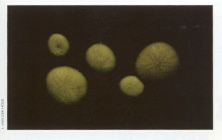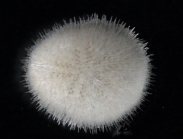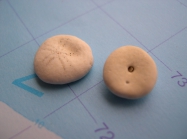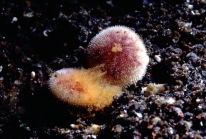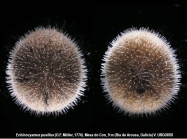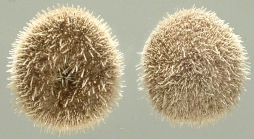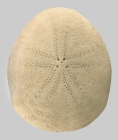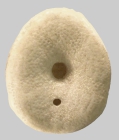
| Introduction | | Search taxa | | Taxon tree | | Specimens | | Attributes | | Literature | | Photo gallery | | Stats | | Log in |
WoRMS taxon detailsEchinocyamus pusillus (O.F. Müller, 1776)
124273 (urn:lsid:marinespecies.org:taxname:124273)
accepted
Species
Clypeaster pulvinulus (Pennant, 1812) · unaccepted (subjective junior synonym)
Echinocyamus angulosus Lütken, 1856 · unaccepted (subjective junior synonym)
Echinocyamus minimus Girard, 1850 · unaccepted (subjective junior synonym)
Echinocyamus minutus (Gmelin, 1791) · unaccepted (subjective junior synonym)
Echinocyamus parthenopaeus Costa, 1868 · unaccepted (subjective junior synonym)
Echinocyamus speciosus Costa, 1868 · unaccepted (subjective junior synonym)
Echinocyamus tarentinus (Lamarck, 1816) · unaccepted (subjective junior synonym)
Echinus minutus Gmelin, 1791 · unaccepted (subjective junior synonym)
Echinus pulvinulus Pennant, 1812 · unaccepted (subjective junior synonym)
Echinus pusillus (O.F. Müller, 1776) · unaccepted (transferred to Echinocyamus)
Fibularia equina Aradas, 1850 · unaccepted (subjective junior synonym)
Fibularia pusilla (O.F. Müller, 1776) · unaccepted (transferred to Echinocyamus)
Fibularia tarentina Lamarck, 1816 · unaccepted (subjective junior synonym)
Spatagus pusillus O.F. Müller, 1776 · unaccepted (transferred to Echinocyamus)
marine,
recent + fossil
(of Spatagus pusillus O.F. Müller, 1776) Müller, O.F. (1776). Zoologiae Danicae Prodromus, seu Animalium Daniae et Norvegiae Indigenarum characters, nomina, et synonyma imprimis popularium. <em>Typis Hallageriis, Havniae.</em> 32: 1-282., available online at http://www.biodiversitylibrary.org/item/47550
page(s): 236 [details]
Description Echinocyamus pusillus is a small sea urchin with an oval, flattened body measuring up to 15 mm long. The calcite skeleton...
Description Echinocyamus pusillus is a small sea urchin with an oval, flattened body measuring up to 15 mm long. The calcite skeleton is completely covered with fine short spines and coloured grey to greenish. Specimens become completely green when injured, a characteristic the species shares with some other sea urchin species. [details] Distribution Echinocyamus pusillus occurred outside the near-coastal zone in both periods. In the 1994-2001 period the species was...
Distribution Echinocyamus pusillus occurred outside the near-coastal zone in both periods. In the 1994-2001 period the species was furthermore observed a number of times in the western coastal zone. Maximum density is 400 ind./m2 (1994-2001 period). [details] Distribution Sublittoral to more than 200 m depth, in coarse sand and fine gravel, common all around British Isles
Distribution Sublittoral to more than 200 m depth, in coarse sand and fine gravel, common all around British Isles [details] Distribution It is dominant at the Cleaver Bank and in the south-western part of the Southern Bight. The species is absent from the...
Distribution It is dominant at the Cleaver Bank and in the south-western part of the Southern Bight. The species is absent from the Wadden Sea, the Delta area, the Voordelta, the Dutch coast and the Oyster Ground. [details]
Kroh, A.; Mooi, R. (2025). World Echinoidea Database. Echinocyamus pusillus (O.F. Müller, 1776). Accessed through: World Register of Marine Species at: https://marinespecies.org/aphia.php?p=taxdetails&id=124273 on 2025-07-16
Nomenclatureoriginal description
(of Echinocyamus angulosus Lütken, 1856) Leske, N. G. 1778. Jacobi Theodori Klein naturalis dispositio echinodermatum . . ., edita et descriptionibus novisque inventis et synonomis auctorem aucta. Addimenta ad I. T. Klein naturalem dispositionem Echinodermatum. G. E. Beer, Leipzig, xxii+278 pp., available online at http://gdz.sub.uni-goettingen.de/dms/load/img/?PID=PPN573613834 page(s): 215-216 [details] original description (of Echinocyamus parthenopaeus Costa, 1868) Costa, O. G. (1867). Monografia degli Echinociami viventi e fossili delle province Napolitane. Atti della Reale Accademia delle Scienze Fisiche e Matematiche. 3/14, 1-9., available online at http://babel.hathitrust.org/cgi/pt?id=mdp.39015035459745;view=1up;seq=376 page(s): 4; pl. 1: fig. 1 [details] original description (of Echinocyamus speciosus Costa, 1868) Costa, O. G. (1867). Monografia degli Echinociami viventi e fossili delle province Napolitane. Atti della Reale Accademia delle Scienze Fisiche e Matematiche. 3/14, 1-9., available online at http://babel.hathitrust.org/cgi/pt?id=mdp.39015035459745;view=1up;seq=376 page(s): 4-5; pl. 1: fig. 2 [details] original description (of Fibularia equina Aradas, 1850) Aradas, A. (1850-1955). Monografia degli Echinidi viventi e fossili di Sicilia. Parte 1a: Famiglia Spatanghi. <i>Atti Accad. Gioenia Sci. Nat. Catania</i>. Serie 2 6-10, 6 (1850): 53-96, 189-216., available online at https://www.biodiversitylibrary.org/page/7995349 page(s): 203-205 [details] original description (of Fibularia tarentina Lamarck, 1816) Lamarck, [J.-B. M.] de. (1816). <i>Histoire naturelle des animaux sans vertèbres</i>, Tome troisième, 586 pp. Paris, Deterville/Verdière. , available online at http://www.biodiversitylibrary.org/item/47702 page(s): 17 [details] original description (of Echinus minutus Gmelin, 1791) Gmelin, J. F. (1791). Vermes. In: Gmelin J.F. (Ed.) Caroli a Linnaei Systema Naturae per Regna Tria Naturae, Ed. 13. Tome 1(6). G.E. Beer, Lipsiae [Leipzig]. pp. 3021-3910. <em>Systema Naturae. Linneaeus (ed.). Ed. 13.</em> 1: pars. 6., available online at http://www.biodiversitylibrary.org/item/83098#5 page(s): 3194 [details] original description (of Spatagus pusillus O.F. Müller, 1776) Müller, O.F. (1776). Zoologiae Danicae Prodromus, seu Animalium Daniae et Norvegiae Indigenarum characters, nomina, et synonyma imprimis popularium. <em>Typis Hallageriis, Havniae.</em> 32: 1-282., available online at http://www.biodiversitylibrary.org/item/47550 page(s): 236 [details] original description (of Echinocyamus minimus Girard, 1850) Girard, C.F. (1850). Observations upon Planarian Worms, with descriptions of several new species of Echinoderms. <em>Proceedings of the Boston Society of Natural History 1848-1851.</em> 3: 363–368. Erratum on p. 396., available online at https://www.biodiversitylibrary.org/page/8870665 page(s): 367-368 [details] original description (of Echinus pulvinulus Pennant, 1812) Pennant, Thomas. (1812). British Zoology. A new edition in four volumes. vol IV. Class V. Crustacea. Class VI. Vermes. Wilkie & Robinson. London. xvi+379 pp. 95 pls., available online at http://biodiversitylibrary.org/page/34933712 page(s): 140-141; pl. 38: figs 1-3 [details] basis of record Hansson, H.G. (2001). Echinodermata, <B><I>in</I></B>: Costello, M.J. <i>et al.</i> (Ed.) (2001). <i>European register of marine species: a check-list of the marine species in Europe and a bibliography of guides to their identification. Collection Patrimoines Naturels,</i>. 50: pp. 336-351. (look up in IMIS) [details] new combination reference Gray, J.E. (1825). An attempt to divide the Echinida, or Sea Eggs, into natural families. <em>Annals of Philosophy, new series.</em> 10:423-431., available online at https://archive.org/stream/annalsofphilosop10lond#page/422/mode/2up page(s): 428 [details] Othercontext source (Deepsea)
Intergovernmental Oceanographic Commission (IOC) of UNESCO. The Ocean Biogeographic Information System (OBIS), available online at http://www.iobis.org/ [details]
context source (BeRMS 2020) Bio-environmental research group; Institute of Agricultural and Fisheries research (ILVO), Belgium; (2016): Macrobenthos monitoring at long-term monitoring stations in the Belgian part of the North Sea from 2001 on. [details] additional source Mortensen, T. (1948). A Monograph of the Echinoidea. IV, 2. Clypeasteroida. Clypeasteridæ, Arachnoidæ, Fibulariidæ, Laganidæ and Scutellidæ. 471 pp., C. A. Reitzel, Copenhagen. page(s): 178-183 [details] additional source Southward, E.C.; Campbell, A.C. (2006). [Echinoderms: keys and notes for the identification of British species]. <i>Synopses of the British fauna (new series)</i>, 56. Field Studies Council: Shrewsbury, UK. ISBN 1-85153-269-2. 272 pp. (look up in IMIS) [details] additional source Muller, Y. (2004). Faune et flore du littoral du Nord, du Pas-de-Calais et de la Belgique: inventaire. [Coastal fauna and flora of the Nord, Pas-de-Calais and Belgium: inventory]. <em>Commission Régionale de Biologie Région Nord Pas-de-Calais: France.</em> 307 pp., available online at http://www.vliz.be/imisdocs/publications/145561.pdf [details] additional source Hansson, H. G. (1998). NEAT (North East Atlantic Taxa): Scandinavian Echinodermata Check-List (Comp.). , available online at https://www.gu.se/sites/default/files/2020-10/NEAT%2AEchinodermata.pdf [details]  Present Present  Present in aphia/obis/gbif/idigbio Present in aphia/obis/gbif/idigbio  Inaccurate Inaccurate  Introduced: alien Introduced: alien  Containing type locality Containing type locality
From editor or global species database
Biology E. pusillus has separate sexes and fertilization takes place externally. The breeding season is in the summer months. The larvae are pelagic. They are characterized by a body skeleton forming a basket-like structure (Mortensen, 1927; Fish & Fish, 1989).E. pusillus is a deposit-feeding clypeasteroid. lts gut content includes sediment, remains of plants and bottom material (detritus), and infauna, especially foraminiferans. E. pusillus is eaten by fish, especially by dab and haddock (Mortensen, 1927; De Ridder & Lawrence, 1982; Fish & Fish, 1989). [details] Description Echinocyamus pusillus is a small sea urchin with an oval, flattened body measuring up to 15 mm long. The calcite skeleton is completely covered with fine short spines and coloured grey to greenish. Specimens become completely green when injured, a characteristic the species shares with some other sea urchin species. [details] Distribution Echinocyamus pusillus occurred outside the near-coastal zone in both periods. In the 1994-2001 period the species was furthermore observed a number of times in the western coastal zone. Maximum density is 400 ind./m2 (1994-2001 period). [details] Distribution Sublittoral to more than 200 m depth, in coarse sand and fine gravel, common all around British Isles [details] Habitat In the Dutch sector of the North Sea E. pusillus mainly occurs in the areas between 20 to 30 m of depth, in coarse to medium sand bottoms. [details] Morphology E. pusillus has an oval, much flattened test of up to 15 mm in length. The test is covered with fine short spines and is greyish or greenish in colour. On preservation or when hurt it turns green, a character distinctive of all clypeasteroids (Mortensen, 1927; Southward, 1972; Fish & Fish, 1989; Hayward & Ryland, 1990). [details] Unreviewed
Breeding Echinopluteus larva. Summer - autumn [details]Distribution It is dominant at the Cleaver Bank and in the south-western part of the Southern Bight. The species is absent from the Wadden Sea, the Delta area, the Voordelta, the Dutch coast and the Oyster Ground. [details] Habitat Echinocyamus pusillus has a preference for medium to coarse-grained sand (median grain size: > 200 μm) and reaches an optimum in sediments with a median grain size of 500-550 μm (relative occurrence: 30%). The species furthermore prefers sediments with a low mud content (maximum 10%). [details] Habitat Known from seamounts and knolls [details]
Encyclopedia of Marine Life of Britain and Ireland
Marine Life Information Network - UK To Barcode of Life (11 barcodes) To Biodiversity Heritage Library (1 publication) (from synonym Echinocyamus speciosus Costa, 1868) To Biodiversity Heritage Library (13 publications) (from synonym Fibularia pusilla (O.F. Müller, 1776)) To Biodiversity Heritage Library (18 publications) (from synonym Spatagus pusillus O.F. Müller, 1776) To Biodiversity Heritage Library (21 publications) (from synonym Fibularia tarentina Lamarck, 1816) To Biodiversity Heritage Library (21 publications) (from synonym Echinus pusillus (O.F. Müller, 1776)) To Biodiversity Heritage Library (281 publications) To Biodiversity Heritage Library (3 publications) (from synonym Echinocyamus parthenopaeus Costa, 1868) To Biodiversity Heritage Library (31 publications) (from synonym Echinus minutus Gmelin, 1791) To Biodiversity Heritage Library (4 publications) (from synonym Fibularia equina Aradas, 1850) To Biodiversity Heritage Library (50 publications) (from synonym Echinocyamus angulosus Lütken, 1856) To Dyntaxa To European Nucleotide Archive, ENA (Echinocyamus pusillus) To GenBank (6 nucleotides; 3 proteins) To Global Biotic Interactions (GloBI) To MNHN Type collection (IE 2013-10532) (from synonym Fibularia tarentina Lamarck, 1816) To PESI (from synonym Fibularia tarentina Lamarck, 1816) To PESI (from synonym Echinus minutus Gmelin, 1791) To PESI (from synonym Spatagus pusillus O.F. Müller, 1776) To PESI (from synonym Fibularia equina Aradas, 1850) To PESI (from synonym Echinocyamus speciosus Costa, 1868) To PESI To PESI (from synonym Echinocyamus angulosus Lütken, 1856) To PESI (from synonym Echinocyamus parthenopaeus Costa, 1868) To USNM Invertebrate Zoology Echinodermata Collection (31 records) To ITIS From editor or global species database
|


